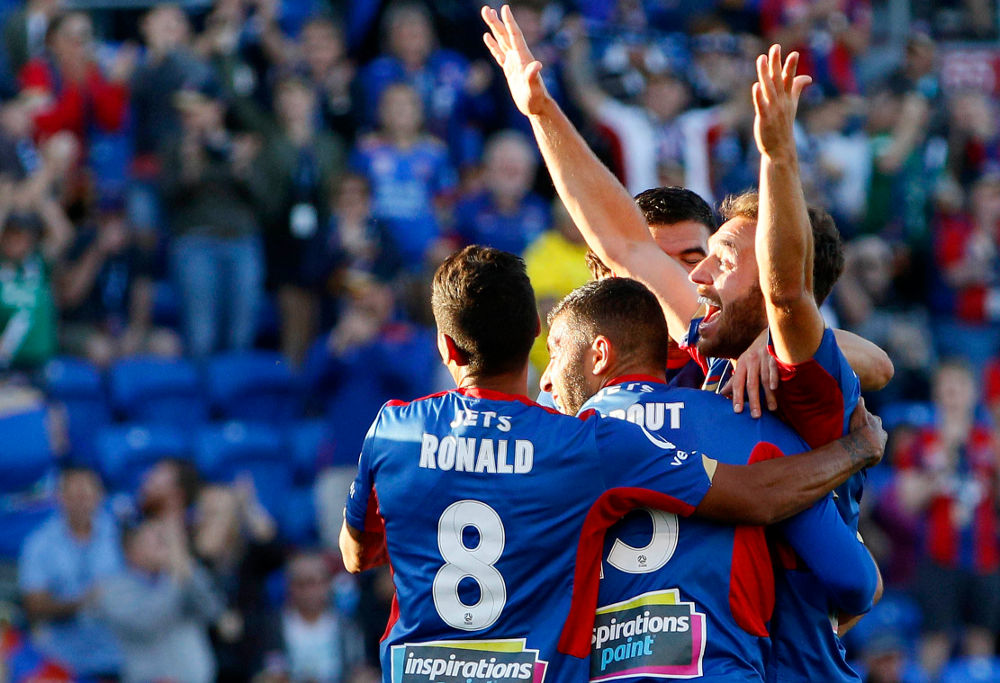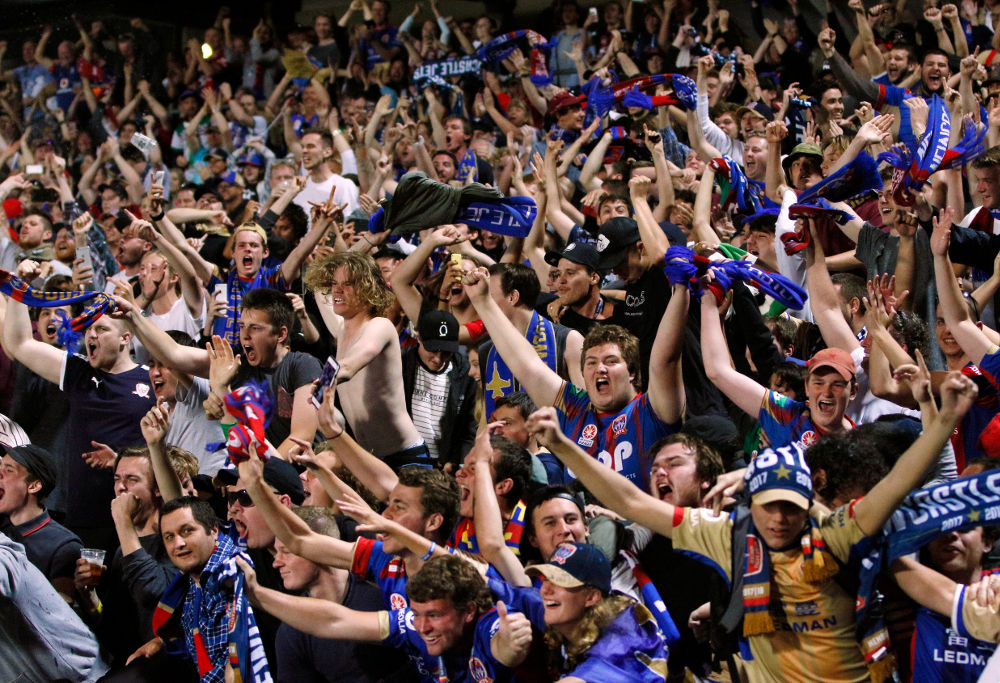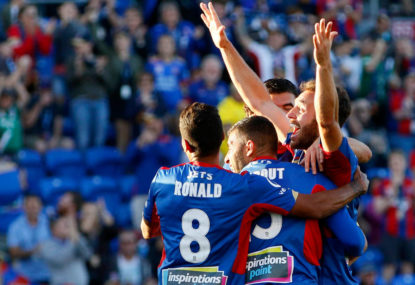Newcastle have now faced every other A-League club once and managed to score against all of them.
With nine games played, the Jets sit second on the table and are squinting into the sunlight, having been the league’s murky basement-dwellers for so long.
They finished the 2016-17 season having scored 28 goals in total. They’ve scored 21 already this season with 18 games remaining.
Ernie Merrick has revived a team that spent the previous few seasons sinking steadily into a deathly rut, turning them into the most potent side in the division over the course of a single offseason.
So far, no team has been able to shut them out – not even the imperious champions Sydney. How has Merrick done this? What new and terrifying weapons has the Scotsman armed the Jets with?
The immediate impression of the Jets’ attacking stats give is one of relentless aggression. The basic metric indicators – goals scored, total shots, shots on target, crosses completed – all place them inside the top three teams in the league. They shoot frequently and accurately, they commit men forward freely and they score goals.
But their passing stats go some way to exposing the mechanisms that whirr beneath this forward-thinking strategy. Newcastle have attempted and completed the second-fewest passes and at a league-worst rate of accuracy. They make the fewest backwards and second-fewest sideways passes as a percentage of their total passes, and they pass forwards more often than any other team.
They make by far the fewest passes per goal and have hit the third-most long passes as a percentage of total passes.
Essentially, their method is propped up by a dogged belief in fast, frequent, forward progress made with as little dallying as possible – an approach that overcomes inefficiency and a small margin for error with frantic repetition and relentlessness.

(AAP Image/Darren Pateman)
Perhaps this stat comparison will illustrate the point best: the Mariners have completed a league-best 3330 passes, and of those just 864 were completed in the opponent’s defensive third, which is about 26 per cent.
Newcastle have completed a league-second-worst 2411 passes, and of those 741 – nearly 30 per cent – were completed in the final third. They are taking and completing fewer passes than nearly every other team but have made forward passing and passing in attacking areas their main priority.
Merrick appears to have streamlined approach play, suppressing tiki-taka fiddling, and is clearly urging his team to dribble with pace and directness. He has also recruited and promoted players to suit this system, a hugely impressive part of his revamp.
Roy O’Donovan is a mobile, voracious striker who can finish with a cold sneer. Joey Champness is a young dasher with a frightening turn of pace and a huge engine. Daniel Georgievski can be potent as a rampaging, overlapping full back. Dimi Petratos is a barrel-chested thumping solo act, a player for whom forward momentum gathers so quickly and who can fire off howitzers with little to no backswing.
Of course, Andrew Nabbout was a perfect pre-existing ingredient too, and imagine how frightening this team would be had Ronny Vargas not been so brutally injured back in October.
This is what happens when a manager formulates a system, arranges a purpose-built team to carry it out and then gets his players to buy in. The eye test backs all this up too.
As far as examples from this season go, perhaps we should look at the Jets’ attacking performance against the league’s worst defensive team, Wellington, to see them operating at their peak level, as barely challenged by an opposing defence as is possible.

(AAP Image/Darren Pateman)
They beat the Phoenix 3-0 and were very active early in the match. Look here how by the end of this move, which begins with a long ball, the Jets end up with seven of their ten outfield players either in or just outside the box. There’s an appetite to feed an attacking move here, that is larger than most teams. Rarely do you see seven defenders, in or around their own box, matched in number by opposition attackers.
Working largely as a lone striker, O’Donovan benefits from the presence of these additional attacking colleagues. The Irishman is a crafty talent, adept at both streaking in behind and dropping deeper to receive the ball at his feet from his defenders or wingers. Here he performs the latter, combining beautifully with Petratos, and here, bunched up with some other Jets on the far side, he darts in to collect a fine lofted pass from Nikolai Topor-Stanley.
In both cases the presence and effort of others is vital. Petratos’ hustle to offer a one-two option in the first clip and then in the second clip the misdirection provided, again by Petratos in the centre and by the rest on the right, sends the Phoenix defence scattering to try and contain things, with O’Donovan slipping through unchecked.
A solitary, isolated striker working in such a direct system will only tire and become frustrated if he’s expected to toil alone and unsupported. Merrick’s system ensures O’Donovan always has at least one complementary man nearby.
Attacking promise, it seems, is held in almost every moment of the game. Look at the way Newcastle set up to receive a free kick, won in their own box and taken by their goalkeeper.
As the ball drops out of the sky onto the head of the man making the first engagement, there are four Newcastle players ahead of him ready to prey on the flick-on, matched up with our Phoenix defenders. The move breaks down, but for a shining moment there was another opportunity, with an abundance of Jets attackers present and with the defence on their heels.
This was all arranged to profit from what was essentially a goal kick. Jets keeper Jack Duncan made just 19 passes in that win over Wellington – the Phoenix’s Keegan Smith, to compare, made 31 – and at a very low completion rate of just 36 per cent, implying the vast majority of his passes were punts into the attacking half rather than short, simple passes to his defenders.
Duncan has the lowest passes attempted and joint-lowest rate of passing accuracy among the eight goalkeepers to have played in six or more games this season, but he has made fourth-most passes into the attacking third. It goes without saying that Merrick’s system does not appear to favour playing out patiently from the back.
The effect all of this has is clear, and not just in the final goals tally: in three of Newcastle’s nine games this year they’ve managed to construct a ten-minute period in which two goals have been plundered – four if you count the two goals scored on either side of halftime in the win over Adelaide.

(AAP Image/Theron Kirkman)
This aggressive style tends to overwhelm when it roars into top gear, and the opponents can be quickly blown away by multiple concessions – the Mariners were in the opening game, the Phoenix were in Round 5 and the Victory were in Round 8. Even in defeat to Sydney the Jets finished the match fighting for an equaliser, pressing Sydney up against their own goal but unable to break through.
They are a team that guarantees at least one rolling 15-minute surge per game, where the throttle is opened up and their full offensive power unleashed.
After so many torrid seasons, heaven knows the fans in Newcastle deserve a team to stand proudly behind. The Jets have entered every contest this season knowing they can score and knowing that that gives them a very good chance to win. They seem set for the finals with things going as they are, and they will be a daunting prospect in a knockout situation.
Merrick, showing auspiciously why he is one of the league’s most decorated managers, is adding further brilliant layers to his already lustrous personal legacy.
With him at the helm, the Jets are flying again, and no-one’s yet worked out how to stop them from firing missile after missile into the goal.
































































































